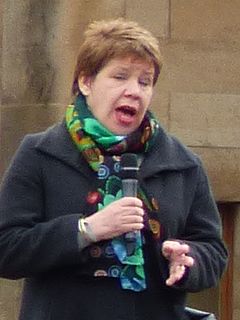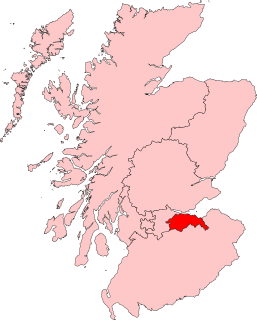Related Research Articles
The politics of Edinburgh are expressed in the deliberations and decisions of the City of Edinburgh Council, in elections to the council, the Scottish Parliament, the House of Commons and the European Parliament.
Local government in Scotland is organised through 32 unitary authorities designated as councils which consist of councillors elected every five years by registered voters in each of the council areas.

Lesley Hinds is a Scottish Labour Party politician who served as Lord Provost of Edinburgh, Scotland from 2003 to 2007.

Edinburgh Pentlands is a constituency of the Scottish Parliament. It elects one Member of the Scottish Parliament (MSP) by the plurality method of election. It is one of nine constituencies in the Lothian electoral region, which elects seven additional members, in addition to nine constituency MSPs, to produce a form of proportional representation for the region as a whole.

Edinburgh South West is a Scottish constituency of the House of Commons of the Parliament of the United Kingdom (Westminster), first used in the 2005 general election. It elects one Member of Parliament (MP) by the first past the post system of election.

Edinburgh North and Leith is a constituency of the House of Commons of the Parliament of the United Kingdom, first used in the 1997 general election. It elects one Member of Parliament (MP) by the first past the post system of election.

Edinburgh Pentlands was a constituency of the House of Commons of the Parliament of the United Kingdom, first used in the general election of 1950, and abolished prior to the general election of 2005. It elected one Member of Parliament (MP) by the first past the post system of election.

Edinburgh Central was a burgh constituency of the House of Commons of the Parliament of the United Kingdom from 1885 to 2005. It elected one Member of Parliament (MP) by the first past the post system of election.

Edinburgh Central is a burgh constituency of the Scottish Parliament (Holyrood). It elects one Member of the Scottish Parliament (MSP) by the plurality method of election. Also, it is one of nine constituencies in the Lothian electoral region, which elects seven additional members, in addition to nine constituency MSPs, to produce a form of proportional representation for the region as a whole.

Edinburgh East and Musselburgh was a constituency of the Scottish Parliament (Holyrood). It elected one Member of the Scottish Parliament (MSP) by the plurality method of election. Also, however, it is one of nine constituencies in the Lothians electoral region, which elects seven additional members, in addition to nine constituency MSPs, to produce a form of proportional representation for the region as a whole.
Scottish Westminster constituencies were Scottish constituencies of the House of Commons of the Parliament of Great Britain, normally at the Palace of Westminster, from 1708 to 1801, and have been constituencies of the House of Commons of the Parliament of the United Kingdom, also at Westminster, since 1801. Constituency boundaries have changed on various occasions, and are now subject to both periodical and ad hoc reviews of the Boundary Commission for Scotland.

Elections to the City of Edinburgh Council were held on 3 May 2007 the same day as the Scottish Parliament general election. The election was the first one using 17 new wards created as a results of the Local Governance (Scotland) Act 2004, each ward will elect three or four councillors using the single transferable vote system a form of proportional representation. The new wards replace 58 single-member wards which used the plurality system of election.

Edinburgh Southern is a constituency of the Scottish Parliament (Holyrood). It elects one Member of the Scottish Parliament (MSP) by the plurality method of election. Also, however, it is one of nine constituencies in the Lothian electoral region, which elects seven additional members, in addition to nine constituency MSPs, to produce a form of proportional representation for the region as a whole.

Edinburgh Eastern is a constituency of the Scottish Parliament (Holyrood). It elects one Member of the Scottish Parliament (MSP) by the plurality method of election. Also, however, it is one of nine constituencies in the Lothian electoral region, which elects seven additional members, in addition to nine constituency MSPs, to produce a form of proportional representation for the region as a whole.

Local elections were held in Scotland on Thursday 3 May 1984, to elect members to all 53 district councils under the Local Government (Scotland) Act 1973, which had established the two-tier system of regions and districts. This was the first election to take place after the 1983 general election landslide victory for the Conservatives. The local elections resulted in the Labour Party taking control of the City of Edinburgh for the first time.

The City of Edinburgh Council is the local government authority for the City of Edinburgh. It was created in 1996 under the Local Government etc. (Scotland) Act 1994, with the boundaries of the post-1975 City of Edinburgh district of the Lothian region.

Elections to the City of Edinburgh Council were held on 1 May 2003, the same day as the other Scottish local government elections and the Scottish Parliament general election.

Elections for the City of Edinburgh District Council took place on Thursday 3 May 1984, alongside elections to the councils of Scotland's various other districts.

Elections to the City of Edinburgh Council were held on 6 May 1999, the same day as the other Scottish local government elections and the Scottish Parliament general election. Turnout was 61%, an increase of 16.5% on the 1995 turnout.
Elections for the City of Edinburgh District Council took place on 3 May 1977, alongside elections to the councils of Scotland's various other districts. These was the second election to the City of Edinburgh District Council. Conservatives won a majority with 34 of the Council's 64 seats.